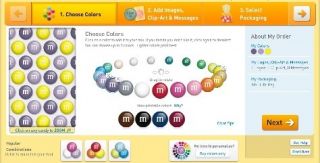Unconscious
The Psychology of Online Customization
The decision to buy a customized product is mediated by unconscious factors
Posted March 13, 2015
Many companies, ranging from major players to small retailers, are discovering the benefits of the personalized digital shopping experience. Online product customization raises brand awareness, increases engagement, helps companies identify emerging trends, and adds an additional source of revenue to their online business. So strong has it become that today many popular brands are embracing the mass customization model, adding it to their business strategy.

The process of customizing products online, also known as Mass Customization, ranges from adding an option to customize a specific product like LongChamp’s Le Pliage Bag customization options, or by adding a new business avenue for the brand like NikeiD, Brooks Brother’s Made to Measure program and My M&M’s.
An extensive study carried out by Bain & Co. on product customization brought attention to the growing consumer interest in online customized options. According to that study conducted on more than 1,000 online shoppers, over 25-30% of the shoppers were interested in online customization options, even if only 10% have tried it at the time. The financial effect means that if 25% of online sales of footwear were customized, that would equate to a market of $2 billion per year.
If you offer customized products or plan to do so, understanding the psychological processes that affect user behavior can assist in offering an engaging customer experience that yields business growth.
From Passive Buyer to Active Partner
Mass customization has become increasingly significant for brand name companies as part of a broader trend that views customers as value co-creators and not just recipients of value. Rather than being a passive consumer, the customer is now becoming a contributor in the product development process.
From a psychological standpoint, the user experience of customizing a product is mediated by a number of unconscious factors that shape the customers’ final decision, even without their awareness. Moreover, the interaction involved in creating the product can lead the customer to buy it – even if they weren’t initially planning on doing so.
Offering the option of customizing products triggers two main psychological processes, which lead to increased user engagement and higher conversions:
“I Created It – Therefore, It’s Mine”
When a product is customized, the buyer’s touch receptors are activated, creating a sensual stimulation. In online purchasing, despite the lack of direct touch, the interaction with the product brings an imaginary path to life. The selection of the product’s features, colors and shape generates thoughts on ‘how it would feel’ to own that object.
According to Schlosser, object interactivity in the context of virtual objects produces more vivid mental images compared to text or static pictures of an object. Those mental images help create higher customer engagement – leading to an eventual purchase of the product.
A ClickTale analysis for a major fast food retailer, showed that conversions were higher when the buyers were able to visualize their orders, despite the virtual customization process.
“I Own It – Therefore, It’s the Best”
Not only do our possessions add value to our lives, but surprisingly, we add value to our possessions. Studies have shown that we value an object more once we have taken ownership of it. The opportunity to express ourselves through the customization promotes an emotional attachment. Furthermore, psychological studies have shown that consumers’ valuation of an object increases once they have taken ownership of it. This phenomenon is explained by theEndowment Effect, according to which, people ascribe more value to things merely because they own them.
Upon interacting with the product during the customization process, people feel that the product is theirs even without legal ownership. That’s the reason people perceive the customized product as more valuable than the standard one. We experience the endowment effect even without legal ownership. As a result, we are willing to pay higher prices for self-designed products compared to non-customized ones and would consider the added premium a reasonable cost to pay.
However, this doesn’t mean that clients want their product to be customized to such an extent that it overcomes the brand presence, especially when the brand is exclusive. A case study we held for a known sports gear brand showed that although people enjoyed customizing the colors, most refrained from the option of adding their initials instead of the brand’s logo. That seemed to disassociate the product from the status symbol connected to the brand.
A Balance between Effort and Value
In our analysis for the sports gear brand, we found that users enjoyed the gaming

aspects of choosing colors and accessories when designing the product. This made them highly engaged in the process to the extent that they spent an average of 20 minutes designing their customized product.
However, be mindful of creating tasks that remain within the scope of most visitors’ attention spans and cognitive abilities. If the consumer is required to invest too much effort, the product will be viewed as inconvenient or annoying. The optimal conversion rate in this case was reached when the process involved no more than 10 steps until check out.
Customization and Gender
A study produced by Wharton School of the University of Pennsylvania titled “Men Buy, Women Shop” revealed significant differences between the shopping behaviors of men and women. The study found that women were more focused on the experience, while men were focused more on the mission. Similarly, ClickTale research shows that the percentage of women using the customization option was higher than the percentage of men. For this reason, in many instances, the customization process may be more effective when directed towards female audiences.
However, in products that are geared towards both genders, in the course of our analysis for a client, we increased conversions when we set out in the early stage of the customization process whether the product is being designed for a male or female user. The analysis showed that having this step located at the end of the design process, made users less satisfied with the outcome of their customization, causing them to abandon the product. A major reason for this is that most of us still act according to gender-biased categorized thinking regarding our apparel and when asked at the end of the customization process whether it was designed for a male or female, it undermined their confidence about the gender representation of their design choices.
Customization Conclusions
A successful and profitable online product customization channel should be built based on the fine balance between the product’s purpose and features, the website design and user experience, as well as the degree of the customer’s personal input. Psychological processes have a major, conscious and subconscious, impact on the customization process.




